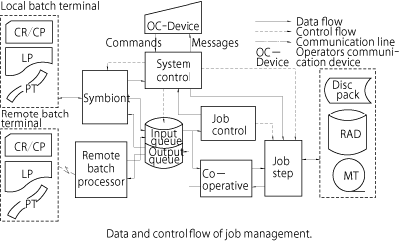For Mitsubishi Electric's MELCOM-7000 series general-purpose computers announced in 1970, the operating systems RBM (Real-Time Batch Monitor), BPM (Batch Processing Monitor), BTM (Batch Time-sharing Monitor) and UTM (Universal Time-sharing Monitor) were provided according to the levels of simultaneous performance of batch processing, remote processing, online real-time processing and time-sharing processing.
RBM was capable of simultaneously performing multiple real-time processing tasks. It could also perform local batch processing concurrently with the real-time processing. The minimum configuration of the main memory was 64 KB (16K words).
BPM had a high-level management function for efficiently performing batch processing, and was capable of simultaneously performing remote batch processing submitted from a remote location and multiple real-time processing tasks. The minimum configuration of the main memory was 128 KB (32K words).
BTM was capable of simultaneously performing time-sharing processing in which up to 38 people could use the system at the same time, in addition to the batch processing and the remote batch processing of BPM. The time-sharing user could request batch processing interactively from a terminal. The minimum configuration of the main memory was 192 KB (48K words).
UTM was an operating system for a large-scale system capable of simultaneously performing batch processing, remote batch processing, real-time processing and time-sharing processing in which up to 128 people could use the system. The minimum configuration of the main memory was 256 KB (64K words).
Each operating system consisted of functions for job management, task management, file management and resource management. These functions had the following characteristics:
This function achieved multi-job execution in which multiple jobs were processed simultaneously..
Jobs submitted from card readers or remote terminals were put into an input job queue on a magnetic disk. Subsequently, a job to be executed was selected from the queue according to its priority by a job scheduling program. And, while the selected job was being divided into a sequence of job steps, the resources required for executing each job step were allocated and the job step was executed consecutively. The output from the job was put into an output queue on the magnetic disk temporarily, and then output to a printer or the like.
The input and output of jobs were simultaneously and concurrently processed with the execution of jobs by a program called Symbiont. It adopted a multi-stream method which enabled multiple input streams and multiple output streams were processed simultaneously.


